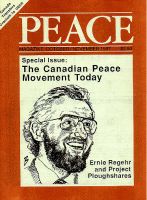
Peace Magazine Oct-Nov 1987, page 9. Some rights reserved.
Search for other articles by Marion Kerans here
(what we found out)
I was one of ten delegates of the Canadian Peace Alliance to a disarmament conference in Moscow, May 13-15. We visited the Soviet Union for two weeks as guests. Most of us assumed that the Soviet Peace Committee, as an official body, was a creature of government and that the funding for this conference and for our visit came partly from their government. We were to find out otherwise. We questioned the area Peace Committees in each of the four cities we visited: Petrozavodsk, near Finland; Lvov and Kiev in the Ukraine, and Moscow.
Each year from April 9 to May 9, the entire population commemorates those who perished in "The Great Patriotic War." The month is given over to educational and memorial activities and to fund-raising for peace. In the city of Lvov alone, out of a population of 2.7 million, a half million persons participated in fifty peace marches and demonstrations. May 9, marks their Remembrance Day. It is a common practice for workers to give one day's wage, referred to as a "peace shift" during the memorial month. All contributions are voluntary. (I suspect the social pressure is similar to office collection for United Appeal Fund Campaigns.) Workers may send their pay directly to the Soviet Peace Fund in Moscow or deposit it to a special bank account. Other imaginative ways of raising money include annual toy bazaars in each school where children sell handmade toys; artists' donations of the sale of their works, benefit music, dance and theatre performances; legacies of money, gold, and jewels. The annual amount raised in 400 million roubles or between 1 and 1.5 ($2-$3) roubles for every Soviet woman, man, and child.
There is no individual membership to either the Soviet Peace Committee or to the Soviet Peace Fund. A school, depending on its size, elects 9-11 members; a large factory 17-25. Within the Lvov area there are over 2000 persons elected to these Committees of Assistants.
The chief purpose of the fund is to grant humanitarian aid to regions which are affected by hunger, war, and natural disasters. Some examples include: disaster relief for Ethiopia, donations to Nicaraguans; kindergarten and medical facilities in Vietnam, aid to Palestinian victims of bombing in Lebanon, supplies to refugees in Kampuchea. Funds to liberation movements are used strictly for humanitarian reasons. "No guns or arms are bought. Only such things as textbooks and hospitals." The Soviet Peace Fund was founded 26 years ago because of the large donations people were making to the Soviet Peace Committee. The Board of Directors is elected from its founding member organizations, including the Soviet Peace Committee, the Red Cross, the Soviet of Friendship, the Soviet Asia Africa Solidarity Society, and others. In each branch office there are two or three full-time staff; an accountant/manager, a combined executive secretary of the Soviet Peace Fund and the Soviet Peace Committee, and an office secretary. Only low income groups receive grants to help them finance their peace activities; wage earners are expected to finance their own. The small staffs are assisted by thousands of volunteers.
By law, the first lesson of the school year in September in every class, at every level, must be about peace. These are given by the members of the Soviet Peace Committee to 45 million students. The volunteers, sometimes war veterans, encourage children and youths to discuss what they can do to strengthen peace. Surprisingly, Soviet school children raise funds to help the children in Afghanistan.
The committee does not consider that it has an obligation to account to the public or to its donors, "rouble for rouble" on how the funds are spent. Newspaper articles explain in general how the money is allocated, which countries receive support, and the number of donors. Personal donations are always recorded, acknowledged, and records are available to donors upon request. Donors may designate their contribution to certain projects whenever possible. There is criticism of the fund for a certain lack of glasnost-which is causing them to re-examine their practices.
The Soviet Peace Committee thinks of their government's policies as coinciding with their own views on disarmament. Although two of the staff present were party members, not all of their staff were. We mentioned the Moscow Group for Trust. However, the official commented impatiently: "Who's against trust? What they are doing sometimes undermines trust!"
Although the Soviet Peace Committee was not critical of it's government's policies, they saw it as their role to support, initiate ideas, and lobby influential government decision-makers for nuclear disarmament With respect to conventional arms, the subject seems to be open for debate. They do not have the answer to the question of how much defence is enough. Nonetheless, they maintained that their military has nothing to lose if the military budget is reduced because theirs is not a profit-based military industrial system like ours.
Some in our delegation feel that the Soviet peace movement has not moved from a policy of "peace through strength." There is no doubt that die Soviets are well aware of the consequences of nuclear war; but whether they believe that war must be abolished is another matter. Remembering their war dead is a powerful force for keeping them armed, just as it motivates them to work and contribute to peace. Since coming home I wonder about all the citizens in the Soviet Union who perished under Stalin and why these twenty million persons are not commemorated as are those who died in war. We still have much to discuss about how to avoid violence.
Marion Kerans, a member of Voice of Women, is working on a biography of Muriel Duckworth, one of VOW's founders.

Peace Magazine Oct-Nov 1987, page 9. Some rights reserved.
Search for other articles by Marion Kerans here